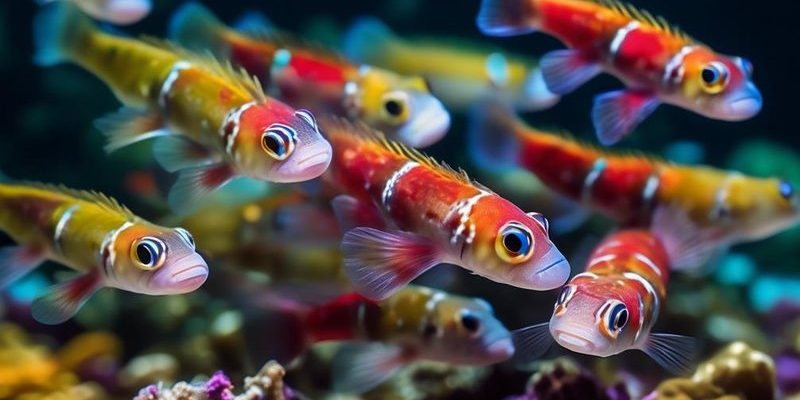
When we think about gobies, we often picture their colorful bodies and unique behaviors. But behind their vibrant appearance is a well-adapted feeding strategy. Gobies are found in various habitats, from tropical coral reefs to muddy estuaries. Their feeding habits adapt to their environment, showcasing the ingenuity of nature. Now, let’s explore the different aspects of their diet and what they snack on.
Understanding Goby Habitat
Before we delve into what gobies eat, it’s essential to understand where they live. Gobies can be found in both freshwater and marine environments, but they mostly thrive in coastal areas. These habitats provide a diverse range of food sources, crucial for their survival.
In coral reefs, gobies often share space with other creatures, from snails to coral polyps. Picture a bustling marketplace, where each stall offers different delicacies! Gobies take advantage of this abundance, foraging for food among the corals and rocks. In estuaries, they adapt their diet to include detritus and tiny organisms that thrive in murky waters. This adaptability is key to their survival.
What Do Gobies Eat?
The diet of gobies varies significantly depending on their habitat and species, but most gobies are opportunistic feeders. This means they eat whatever is available and can change their diet based on local food supplies. Typically, they consume:
- Algae: Many gobies graze on algae found on rocks and coral surfaces, much like how you might pick apart a salad to find your favorite toppings.
- Small Invertebrates: They enjoy munching on tiny shrimp, crabs, and snails. Imagine a tiny seafood buffet, where everything is bite-sized!
- Zooplankton: Some gobies filter feed, using their mouths to catch tiny planktonic animals drifting in the water.
These dietary choices not only fill gobies’ bellies but also play a pivotal role in maintaining the balance in their ecosystems. By eating algae, gobies help prevent algal overgrowth that can suffocate coral reefs.
Feeding Techniques of Gobies
Goby feeding techniques are as varied as their diets. They employ several strategies to snag their meals. Here are some common techniques you might notice:
Grazing
A lot of gobies are grazers, much like cows on a pasture. They will slowly move along surfaces, nibbling on algae as they go. This method is vital for species like the cleaner goby, which removes parasites from other fish while dining on algae.
Ambush Predation
Some gobies are stealthy hunters, lying in wait for small invertebrates to come close. With a quick dart, they snatch their prey, akin to a cat pouncing on a mouse. This behavior showcases their adaptability and skill.
Filter Feeding
Certain goby species are filter feeders. They swim through the water with their mouths open, trapping tiny organisms. Think of them as miniature whales, using their mouths to collect food while gliding through the ocean.
The Importance of Goby Diet in Ecosystem Health
Gobies play a crucial role in their ecosystems. Their feeding habits help maintain the health of coral reefs and aquatic environments. By grazing on algae, they prevent overgrowth that can lead to coral suffocation. This balance is vital for all creatures that rely on coral reefs for shelter and food.
Moreover, gobies serve as prey for larger fish and animals, creating a food web that sustains various marine life. If goby populations were to decline, it could have a ripple effect throughout their ecosystem.
Common Myths About Gobies and Their Diet
Despite their fascinating feeding habits, there are a few myths surrounding gobies and their diets. Let’s clear some up:
Myth: Gobies Only Eat Algae
While gobies do consume a lot of algae, they’re not strictly herbivores. Many goby species eat a mix of algae, invertebrates, and even small zooplankton.
Myth: All Gobies Are the Same
That’s far from true! There are hundreds of goby species, each with unique dietary preferences and feeding techniques. Just like people have diverse tastes, gobies adapt their eating habits based on their specific habitats and available food sources.
Myth: Gobies Don’t Impact Their Environment
On the contrary, gobies significantly impact their ecosystems. By eating algae and invertebrates, they help maintain the health of coral reefs, ensuring that these vital habitats continue to thrive.
Feeding Gobies in Captivity
If you’re considering keeping gobies in an aquarium, it’s important to mimic their natural diet as closely as possible. Here are some tips for feeding gobies in captivity:
- Variety is Key: Offer a mix of high-quality flakes, frozen or live brine shrimp, and algae wafers. This variety will keep your goby healthy and happy.
- Monitor Feeding Habits: Watch how much they eat and adjust the amount accordingly. Overfeeding can lead to water quality issues.
- Avoid Processed Foods: Stick to natural foods for the best nutritional value. Just like us, gobies thrive on whole foods over processed options.
By providing a balanced diet, you’ll help your gobies flourish in their new home.
Understanding the diet and feeding habits of gobies reveals just how remarkable these little fish really are. From their diverse feeding techniques to their vital role in the ecosystem, gobies are more than just colorful fish swimming along the reef.
Their adaptability to different diets helps maintain balance in their habitats, making them essential players in the aquatic world. So, whether you’re observing gobies in nature or caring for them in your home aquarium, appreciating their unique habits can deepen your love for these charming creatures. Isn’t it amazing how much there is to learn from the underwater world?

